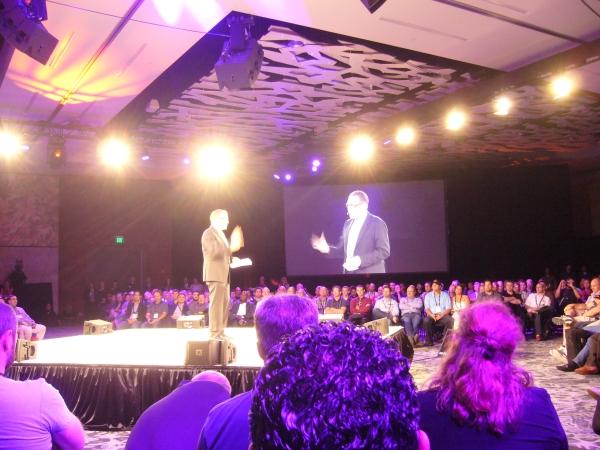CEDIA Keynoter Ponders Future of VR, Smart Sensors & More

As the speech unspooled, audience members participated by texting terms to a word cloud that periodically filled the projection screens.
Rogers believes the tech industry will continue to experience "exponential growth" through the 2020s due to Moore's Law, which posits that processor power will continue to multiply, and Metcalfe's Law, which says that the internet grows as a square of the number of people participating. He painted a sweeping portrait of "virtualized life," with everyone connected to the internet 24/7, whether consciously or unconsciously.
He's bullish on smart glasses, despite the failed Google experiment. He says the next generation will include video projectors that produce the equivalent of a 50-inch transparent screen before your eyes while the audio transducers use bone conduction to conjure up sounds "like voices in your head." Also coming, courtesy of South Korean companies he scrupulously identified as clients, are watchbands whose entire surfaces are bendable video displays. Ambient telepresence will use giant video screens, in offices or homes, which create the appearance of an extension of the room, mixing real and virtual into a seamless whole. You'd have conversations with coworkers or relatives.
Virtual reality, he warned, can be both "isolating and powerful." Wired and wireless broadband networks will blur together, following you around and seamlessly handing off to one another, with the help of emerging 5G networks. They will be so all pervasive, he said, that "we are going to have to teach kids what offline is."
Smart sensors will be in everything, and they needn't necessary rely on batteries—they might simply harvest energy from the environment. His favorite example was the smart dumpster, developed by a consortium in Italy, and coming soon to the U.S. These dumpsters even have their own Twitter accounts. Smart sensors in the home will use not just facial recognition but emotion detection.
This was the trigger for a Steve Jobs story in which Rogers asked Jobs (somewhat bittersweetly, we now recognize) what kind of computers he would be marketing at age 75. Jobs answered that toddlers would unbox their first computers which would immediately ask "what's your name?" Later in life you might own a computer that knows you so well, it can serve as a virtual psychotherapist. "Houses will have personalities," he promised.
At this point Rogers began circling back to facts on the ground—namely the integrators who presumably will master and help deliver these new technologies. He described three levels of "luxury software" using an aviation metaphor. Coach would be Microsoft and Android. Business class would be Apple. And first class would be a new kind of software that brings together ease of use ("which can slip away"), privacy (better than we have now), and security. It would all add up to a "home experience that really fits you like a good custom suit."
Integrators have a key role in an ongoing R&D project as they meet with customers and manufacturers and shape the future: "We're all a part of it and it's your future to build."













































